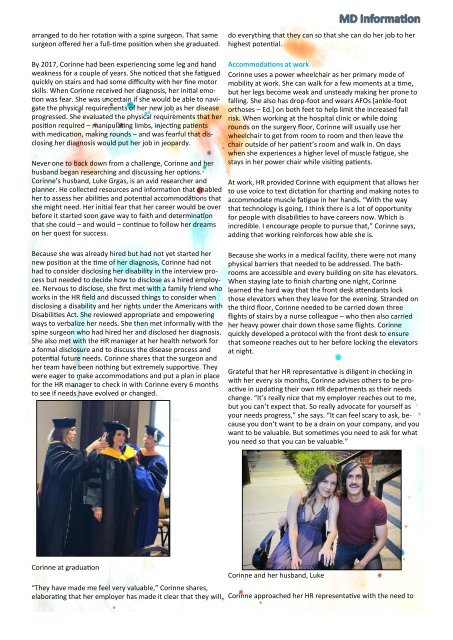MDF Magazine Issue 72 December 2023
You also want an ePaper? Increase the reach of your titles
YUMPU automatically turns print PDFs into web optimized ePapers that Google loves.
arranged to do her rotation with a spine surgeon. That same<br />
surgeon offered her a full-time position when she graduated.<br />
do everything that they can so that she can do her job to her<br />
highest potential.<br />
By 2017, Corinne had been experiencing some leg and hand<br />
weakness for a couple of years. She noticed that she fatigued<br />
quickly on stairs and had some difficulty with her fine motor<br />
skills. When Corinne received her diagnosis, her initial emotion<br />
was fear. She was uncertain if she would be able to navigate<br />
the physical requirements of her new job as her disease<br />
progressed. She evaluated the physical requirements that her<br />
position required – manipulating limbs, injecting patients<br />
with medication, making rounds – and was fearful that disclosing<br />
her diagnosis would put her job in jeopardy.<br />
Never one to back down from a challenge, Corinne and her<br />
husband began researching and discussing her options.<br />
Corinne’s husband, Luke Grgas, is an avid researcher and<br />
planner. He collected resources and information that enabled<br />
her to assess her abilities and potential accommodations that<br />
she might need. Her initial fear that her career would be over<br />
before it started soon gave way to faith and determination<br />
that she could – and would – continue to follow her dreams<br />
on her quest for success.<br />
Because she was already hired but had not yet started her<br />
new position at the time of her diagnosis, Corinne had not<br />
had to consider disclosing her disability in the interview process<br />
but needed to decide how to disclose as a hired employee.<br />
Nervous to disclose, she first met with a family friend who<br />
works in the HR field and discussed things to consider when<br />
disclosing a disability and her rights under the Americans with<br />
Disabilities Act. She reviewed appropriate and empowering<br />
ways to verbalize her needs. She then met informally with the<br />
spine surgeon who had hired her and disclosed her diagnosis.<br />
She also met with the HR manager at her health network for<br />
a formal disclosure and to discuss the disease process and<br />
potential future needs. Corinne shares that the surgeon and<br />
her team have been nothing but extremely supportive. They<br />
were eager to make accommodations and put a plan in place<br />
for the HR manager to check in with Corinne every 6 months<br />
to see if needs have evolved or changed.<br />
Accommodations at work<br />
Corinne uses a power wheelchair as her primary mode of<br />
mobility at work. She can walk for a few moments at a time,<br />
but her legs become weak and unsteady making her prone to<br />
falling. She also has drop-foot and wears AFOs [ankle-foot<br />
orthoses – Ed.] on both feet to help limit the increased fall<br />
risk. When working at the hospital clinic or while doing<br />
rounds on the surgery floor, Corinne will usually use her<br />
wheelchair to get from room to room and then leave the<br />
chair outside of her patient’s room and walk in. On days<br />
when she experiences a higher level of muscle fatigue, she<br />
stays in her power chair while visiting patients.<br />
At work, HR provided Corinne with equipment that allows her<br />
to use voice to text dictation for charting and making notes to<br />
accommodate muscle fatigue in her hands. “With the way<br />
that technology is going, I think there is a lot of opportunity<br />
for people with disabilities to have careers now. Which is<br />
incredible. I encourage people to pursue that,” Corinne says,<br />
adding that working reinforces how able she is.<br />
Because she works in a medical facility, there were not many<br />
physical barriers that needed to be addressed. The bathrooms<br />
are accessible and every building on site has elevators.<br />
When staying late to finish charting one night, Corinne<br />
learned the hard way that the front desk attendants lock<br />
those elevators when they leave for the evening. Stranded on<br />
the third floor, Corinne needed to be carried down three<br />
flights of stairs by a nurse colleague – who then also carried<br />
her heavy power chair down those same flights. Corinne<br />
quickly developed a protocol with the front desk to ensure<br />
that someone reaches out to her before locking the elevators<br />
at night.<br />
Grateful that her HR representative is diligent in checking in<br />
with her every six months, Corinne advises others to be proactive<br />
in updating their own HR departments as their needs<br />
change. “It’s really nice that my employer reaches out to me,<br />
but you can’t expect that. So really advocate for yourself as<br />
your needs progress,” she says. “It can feel scary to ask, because<br />
you don’t want to be a drain on your company, and you<br />
want to be valuable. But sometimes you need to ask for what<br />
you need so that you can be valuable.”<br />
Corinne at graduation<br />
“They have made me feel very valuable,” Corinne shares,<br />
elaborating that her employer has made it clear that they will<br />
Corinne and her husband, Luke<br />
Corinne approached her HR representative with the need to

















